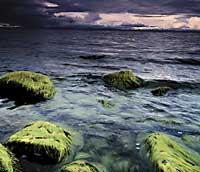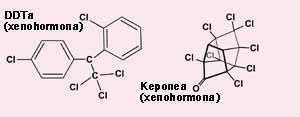Growing the world

The amount and quality of sperm that men generate in recent decades is decreasing and there is doubt that the cause is not pollution, more specifically it is suspected that it is due to compounds that act as hormones. These compounds are also called endocrine disruptors, or xenohormone, to differentiate them from the hormones produced by the body itself, and are able to turn the endocrine system upside down.
30 years ago, in 1975, by accident, a compound called kepone was poured into a river in the North American state of Virginia. This substance was used as an ingredient to make a pesticide. And after studies of men who had contact with the strain as a result of the spill, they had less sperm. This compound behaved like an estrogen.
Surprising conclusions
By then similar facts were observed in animals. In the early 1970s it was discovered that in some polluted rivers there were more females than males. Few expected this ‘emitting’ to be due to compounds that were poured into the wastewater. In fact, these substances were produced for other purposes, most of them pesticides and herbicides, and they did not structurally resemble estrogen. It took ten years to show that these substances acted as hormones, to realize that they were xenhonors.
They are very striking cases: male perch with eggs, turtle eggs and bird with shell softer than normal... And don't think those curiosities are on the other side of the world: The study of the pearls of the lower Ebro river has revealed that males have less testosterone than normal and that they have a hectic spermatogenesis and that females arrive later than normal, among other things.

The problem of increased perch has been detected in many European rivers, so we are investigating the rivers of the whole continent, and we want to see how pollution has affected the endocrine system of species in the aquatic environment. And not only in Europe, of course, but all over the world, and especially in the United States. There they found the first signs of disruptive hormones.
One of the events that has had the most impact on the media has also taken place in the United States and has to do with alligators. The alligators of Lake Apopka of Orlano have a 25% lower penis than usual, and not only that, but the level of testosterone in blood is very low, equivalent to that of the females. A zoologist from the University of Florida analyzed the data he received between 1994 and 95. He compared the data collected in the apopan with others from a lagoon located just 50 kilometers away. The differences in climate and food resources are not significant between two lagoons, with the greatest difference being pollution.
In 1980 a serious spill occurred in the Apopka Lagoon: in a chemical industry a well of rubble was overflowing and pesticides were poured into the lake, including DDT. Only one in ten alligators made progress, although water quality increased as it recovered. However, the emitted compounds had already been introduced into the food chain and in a few years their influence became evident.
To demonstrate that the relationship between DDT and the low testosterone level of alligators was correct, we worked in laboratory with alligator eggs. And the results did not say otherwise, on the contrary, they assured that DDT acted as a disruptive hormone that influenced the reproductive physiology of alligators.
Apparently, to a greater or lesser extent, they are able to cause inadequate or disproportionate responses to the endocrine system, so they are considered to cause damage to the development of the fetus, its reproductive capacity and behavior, as well as excessive cell growth (carcinogenesis).
Complex mechanism

The truth is that the chemical structures of xenhonrin do not resemble estrogen and, however, they associate the estrogen receptor of the cell and favor the response of the endocrine system, which actually compares more with estradiol than with estrogen, which is the functional structure of estrogen.
However, not all compounds have the same effect: most produce a weaker response than estrogen, but when there is more than one compound (as actually happens in a river) the response is much greater than the sum of what these compounds would individually produce, it multiplies.
The relationship between estrogen and receptor has been explained as an analogy of the relationship between lock and key. One estrogen zone fits another of the receptor, such as the key in the lock. However, as can be seen, the receptor lock also adapts compounds in its structure that do not resemble this ‘key’. Sometimes the same effect as estrogen is achieved, known as xenoestrogens, and sometimes receptor blocking occurs, which are anti-estrogens.
The key to the impact measure is considered to be the relationship between the compound and the receptor. In fact, estrogen is associated with a specific receptor and together they attract a second receptor. Estrogen-free molecules in the cytoplasm tend to bind to this simple receptor. This way the estrogen dimer receptor is formed, i.e. two pairs of estrogen receptors. And this dimer is associated with the DNA chain and a gene is awakened or muted.
Xenoestrogens act the same. Apparently, the ability of the second receptor associated to attract another estrogen or xenoestrogen depends on the relationship between the xenoestrogen receptor. The more attractive the second receiver is, the faster and more abundant the response it generates.
Looking for evidence

When a compound is suspected to be disruptive, several tests are performed in the laboratory. Among other things, you want to know if the substance acts as a disruptor or not and to what extent it affects.
Some tests are done with animals, but others with cells. One of them is the Litmus test. Yeast cells are used to which receptors and human estrogen sensitive gene are incorporated, as well as another gene that denounces an estrogen-like response; if the tested compound activates the estrogen gene, the cell is whipped.
Through this bioassay, the ‘estrogenicity’ of many compounds has been measured, but not only individually but as a whole, and in some cases it has been observed that a compound can have in group a response thousand times greater than the individual, measured according to the intensity of blue color adopted by the cell. One hypothesis to explain this is that the receptors have more than one space to associate xenoestrogens, and that when two xenoestrogens are attached to a receptor, the responses are much more numerous than the individual ones.
As you can see, much remains to be investigated. Humans produce around 100,000 compounds not present in nature, which in one way or another reach the environment and, above all, water.

All this is so new that researchers have a responsibility to establish a solid scientific basis on this issue. There are many questions that need to be answered: which contaminants can act as a hormone, if they have a long life or if, on the contrary, they degrade easily, accumulate in the food chain, why some have influence of estrogen and others otherwise, what other functions of the endocrine system can damage, in what amounts are dangerous, affect the human being, etc.
In addition, synthetic hormones that also reach rivers are found and are suspected to affect the endocrine system of fauna. Well, responding consistently to these suspicions will be critical to preventing the problem. If we’re on time… that’s another thing.
Natural, synthetic and other estrogens

Although estrogens are produced by both females and males, they are especially important for the development of female reproductive organs and for cyclic activity of ovaries. Therefore it is said that they cause the characteristics of the females. Estrogens are steroid hormones, based on the structure of cholesterol, like progestins and androgens, of cyclopentanofenantrene.
Synthetic estrogens (drugs synthesized to regulate estrogen activity) do not have a similar structure, but the most surprising thing is that some xenoestrogens, pesticides and herbicides have a different structure, look at the compound called kepone. It seems a lie that the influence of estrogen is the same in cells.

And what about plant estrogens?

Compounds that act as animal estrogens are not only synthetic compounds, but also industrial waste if they have been natural in plants. They are known as phytoestrogens and are found in soy, rice, potato, apple and garlic, among others, in daily foods.
The most researched are probably soy isoflavones. In fact, it is known that in some Asian countries there are fewer cases of hormonal cancer and that women have fewer problems in menopause. In these countries a lot of soy is consumed and it seems that these benefits are derived from soy isoflavone.
Sometimes phytoestrogens are beneficial, but they can also be harmful if taken in excess: according to animal studies, they can influence reproduction, such as mandaperejil (Daucus carota), wrote Hippocrates, which prevented pregnancy. IV. In the 20th century it has been found to contain a compound that blocks progesterone. However, it is difficult for a man or woman to ingest an excess of phytoestrogens in the diet, as for this he should only eat food with phytoestrogens in the diet, and vegetarians hardly.





